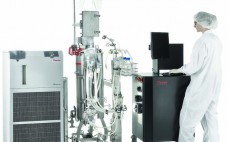During the past decade, single‑use bioprocessing has emerged as a standard platform for current good manufacturing practice (CGMP) mammalian cell culture. Biomanufacturers have come to appreciate the benefits of lower capital and operating costs, reduced contamination risk, continuity from early development through manufacturing, flexibility, and sustainability (1). Disposable cell‑culture vessels have gained wide acceptance because their performance duplicates that of stainless‑steel, fixed‑tank bioreactors, with which manufacturers have extensive experience. This is no accident: Single‑use bioreactors use stainless–steel engineering principles, particularly…
Fermentation
Automation of Microbioreactors
Current methodologies in genetics and microbiology enable researchers to influence metabolic pathways of microbial cells in many directions. Beside the academic interest in investigating fundamental functions in metabolic pathways, commercial production of valuable compounds by microbial hosts is state of the art. For example, such products include enzymes (lipases, proteases, phytases), therapeutic agents (insulin, antibodies), bulk chemicals (lysine, glutamate, citric acid), or the microbial cells themselves (used in brewing or milk processing), with therapeutic agents probably the fastest growing market.…
Advances in Sensor Technology Improve Biopharmaceutical Development
Today’s biomanufacturing operations require constant management of biopharmaceutical process attributes throughout process development and production. Continuous online measurements of pH, dissolved oxygen (DO), oxidation–reduction potential (ORP), and conductivity (Figure 1) allow real-time industrial process monitoring and adjustment. These functions are crucial to process improvement studies and accurate, reliable manufacturing of high-quality products. Figure 1: () “In the pharmaceutical industry, it is extremely valuable to see how an attribute changes with time and correlate that change with parts of the process,”…
High-Yield Production of PASylated Human Growth Hormone Using Secretory E. coli Technology
Since the 1985 approval of the first recombinant human growth hormone (hGH, such as Protropin/somatrem human growth hormone from Genentech, now Roche), the number of clinical indications for therapy with hGH has steadily increased (1). That led to a highly successful drug with more than US$3 billion sales in 2011 (2). Even so, hGH shares a common problem with most other first-generation protein therapeutics: a very short plasma half-life of just about two hours in humans. Because such biologics are…
Process Optimization of Biosimilars Production Using NMR Profiling
With a compound annual growth rate potential of ∼52% during 2010–2015 (1), the global biosimilars market represents a significant driver in biologics development and manufacture. Increased competition, quality-by-design (QbD) directives, and rising costs are compelling biosimilars manufacturers to search for advanced technologies they can use in optimizing production processes to remain competitive and maximize new opportunities. Here, we discuss biomanufacturers’ needs for robust, standardized cell-culturing procedures that comply with QbD directives. We also describe an effective new NMR-based bioanalysis technology.…
Screening Yeastolate Raw Material Used in Insect Cell Culture Media
Insect cell culture is widely used as an industrial platform in recombinant protein production for research and diagnostics (1, 3,4,5). Many commercial yeastolate products are intended as nutritional supplements for not only insect cell culture, but also for mammalian cell culture and bacterial fermentation applications (6,7,8,9,10,11,12,13,14,15). Yeastolate plays an important role in modern biological production because it can be very effective in promoting insect cell growth and enhancing production of recombinant proteins. The product is known to contain amino acids,…
Analysis of Bacterial Biomass Growth and Metabolite Accumulation
Mathematical modeling has been widely used in microbiology and biotechnology for several decades. The main objective of modeling is to find optimal conditions for microbial growth and biosynthesis of useful metabolites. We modified the well-known equation of Perth–Marr (1) — proposed to calculate the energy consumption of a substrate— to analyze the energy consumption by cells for growth and viability maintenance. Our study includes that theory along with our own development. Our initial modeling work was carried out with Yersinia,…
A New Kinetic Structured Model for Cell Cultivation in a Chemostat
Mathematically modeling the kinetics of batch and continuous cultivation allows you to not only calculate and evaluate the effects of process parameters, but also to forecast those parameters and duration of cultivation to develop a cost-effective production process. Mathematical modeling microorganism cultivation was intensively developed in the second half of the last century. Equations 1–6: () Monod proposed Equation 1 for batch processes in 1942 (1). In that equation, µ and µmax are the specific and maximum…
A Decade of Microbial Fermentation
Microorganisms play a vital role in modern life — with applications ranging from wine fermentation to biofuel production to solutions for complex mathematical problems (1). During the past decade, microbial fermentation for protein production reached a higher level of sophistication and wider adoption. When BPI was first published in 2003, the physical and biological characteristics of many microbial cells and the attributes of their fermentation processes were well known. Nonetheless, the economic environment at that time created immense pressure on…
NIR Spectroscopy Analysis of Phosphate Salts
Confirmation of raw material quality is a vital part of biopharmaceutical manufacturing processing. Incorrect or poor-quality vendor materials account for a considerable portion of failed and recalled product. To prevent these expensive problems, strict quality control (QC) procedures are often implemented and used to screen for inappropriate incoming materials. QC procedures commonly used are chemical tests that involve removing samples to a laboratory and performing, which can at times be complex, time-consuming, and laborious protocols. A common test procedure that…

